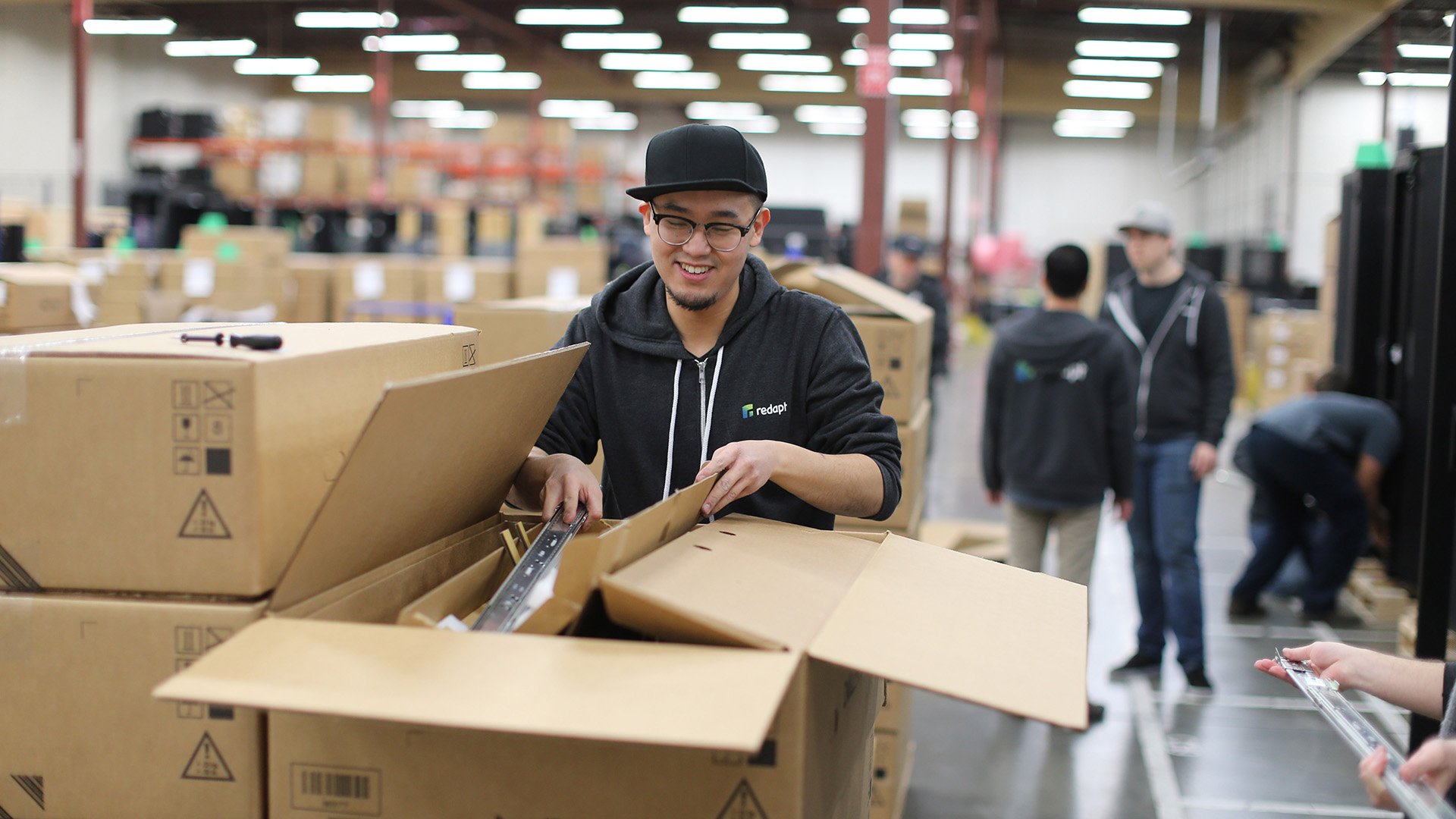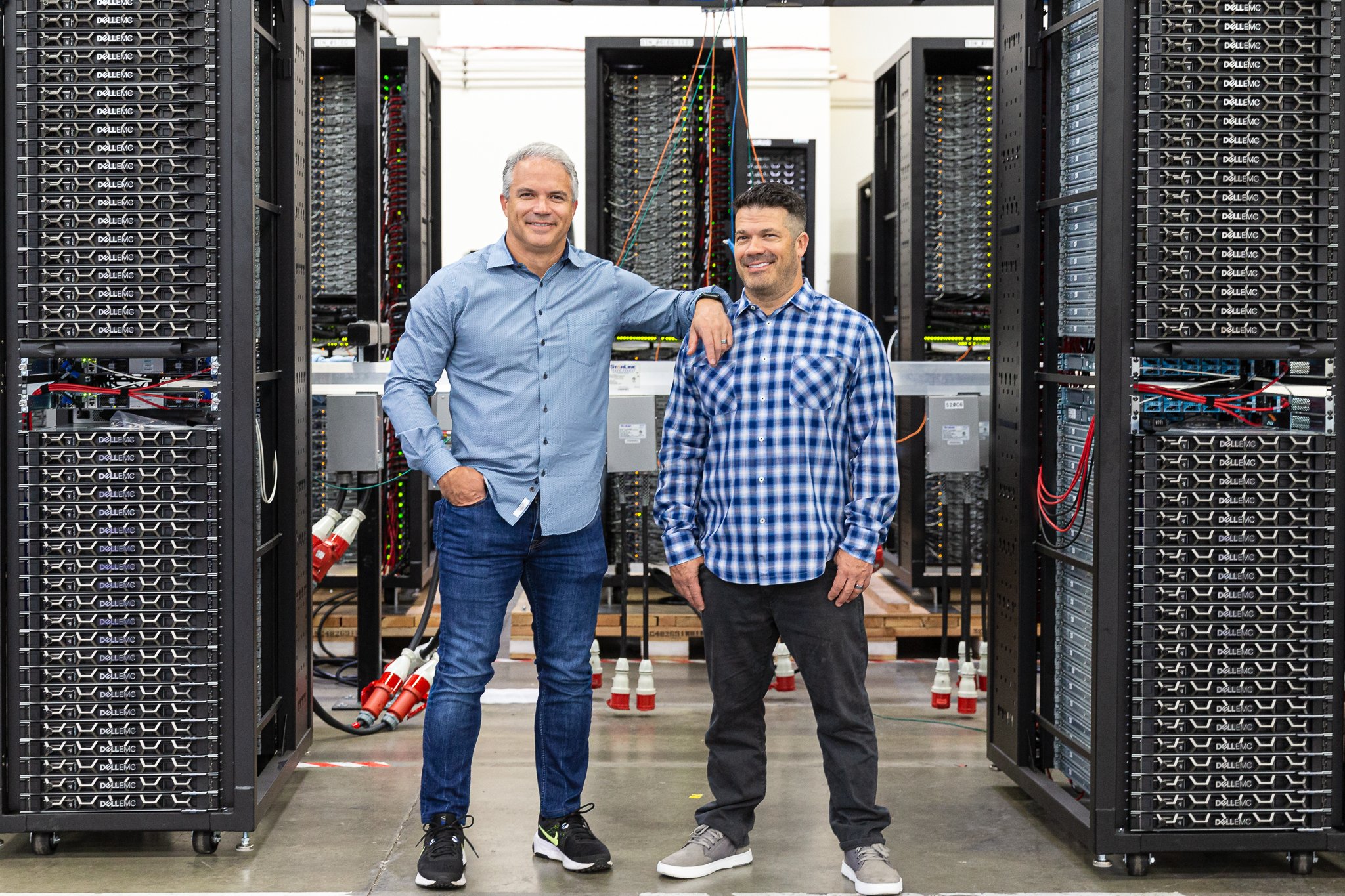Sarah Jones (00:11):
All right. Well, good morning, everyone. Welcome to Redapt's Deploying Managed Kubernetes with Dell EMC and Google Anthos webinar. I am Sarah Jones, I am with Redapt marketing, and I'll be helping host today. Let's jump in.
Why are you here? You want to modernize your IT to stay competitive. You need solutions to the challenges your IT teams face, and you want to learn more about the options available to you today. We have our Redapt experts Matt Francis and Vishnu on the line. We’ll be speaking with both of them throughout the webinar. Matt has 20 years of experience in the IT industry, with the past seven years spent working hands-on with customers to adopt HCI platforms, and five years implementing persistent storage solutions for Kubernetes for clients.
Vishnu specializes in IT leadership, with extensive experience in strategy and organizational development, project management, system integration, enterprise cloud architecture, business intelligence, and much more. I will hand it over to Matt and Vishnu.
Vishnu Arunachalam (01:45):
Thanks, Sarah. So we'll quickly go over the agenda, in terms of what we'll be covering today, and then we'll dive into some of the details. We want to start off by giving a lay of the land, in terms of what we are doing today and the state of the industry. I'll talk a bit about some of the goals and challenges CEOs and CIOs are facing today as part of that section. Then, once we have an understanding of the goals and challenges, then we'll dive more into the solution aspect of it, and helping you with ideas around how some of the modern development practices and technologies, such as Kubernetes, Google Anthos and Dell EMC infrastructure, could help in solving some of those challenges.
Then we'll follow through with some examples, in terms of how we've implemented Anthos for some of our customers, and also talk about the benefits you can see within your organization. Finally, we’ll cover how Redapt can partner with you and help in the long term. Can you move to the next slide, Sarah?
Here's the lay of the land, in terms of how we understand and where things stand. These are numbers we pulled from McKinsey Digital, the survey that they did in July 2019. Three of these numbers sounded very interesting to us. We popped them up here, so we can have a discussion around this, and that indicates the state of the industry, right? When we look at the top three things in a CEO's mind, 88% of them are looking at accelerating revenue. This is across all industries, whether it is a large enterprise focused on growing their revenue, or a small startup basically trying to get into the market and grow their revenue footprint. We're seeing that larger enterprises are trying to innovate constantly and bring back new revenue streams.
It could be new product ideas, or growing their existing customer base, even penetrating into new geographies, or catering to a new demographic. All of these are great ideas, and they are trying to innovate and stay on top of the curve. In similar fashion, when you look at small startups, they're trying to disrupt these larger companies. For example industries where you can see this are communication, insurance, finance, and hospitality. These are the Ubers of the world. If we're trying to figure out, “How do I disrupt an industry that's been in existence for a long time, and to get a revenue acceleration going on in these areas?” Quite often, what we find out is that, in today's landscape, these ideas are more digital in nature. The CIOs are partnering with the CEOs to achieve these revenue aspirations.
The second number we see is that about 71% of them are looking at improving agility and speed to market. Now that we've established digital is a key area they're focused on in terms of driving revenue, agility becomes more important within the competitive landscape. The quicker you can bring features to the market—it’s more important. That's visible today in our COVID landscape and what we're facing right now. Agility is required in terms of how to find the next vaccine, right? Also around the technology side, in terms of how we can implement the best available contact tracing capabilities and who can be the first to get to market there. So agility becomes more important and defining for some of these businesses, especially around healthcare. The bottom line is, “How can I get things done quickly?”
That's something that's on top of the CEO's mind. The landscape has changed so it isn’t about releasing that one perfect product, but more about how quickly you can adapt your product to any of the changing users’ demands. That's how CEOs are thinking today. “Is my team, is my platform, is my product capable of doing that?” It is not only about success. It is also about, “If I'm failing, can I fail fast? Do I have clear metrics to understand that I'm failing? Can I pivot and take a different direction? Because of the larger number of ideas I can experiment on, there is always this inclination towards starting small. But, not having any growing pains when I want to shoot back, how do I address those challenges?”
How do they get that kind of agility and how do they enable automation across the entire organization, so they can get speed to market and get that agility working? That's a key goal for a lot of those CEOs, in consensus with what McKinsey is reporting and what we are seeing on a daily basis, as we talk to CEOs and CIOs across organizations. The last one is that about 47% is cited around cost reductions. This number could have probably gone a lot higher if we did this survey right now, I think. Given the COVID situation, we're getting calls from companies, large and small, talking about cost optimization and cost reduction, in light of the current situation. Business continuity is kind of taking a different shape today.
If there is capability for me to reduce my spend, that basically ensures business for me in the COVID landscape today. How do I operate more efficiently?” This is something every CEO is thinking about. “How can I replace my legacy apps with modern apps? So, that can basically scale in or scale out and scale back in this world.” If I'm a retailer who's having a heavy amount of production in my e-commerce site, I want to have the capability of basically scaling that out, so I'm giving a great experience for any customer who comes in. At the same time, in a situation like COVID where my sales are shrinking, I need to have the capabilities of scaling it back in. That way I can see that same level of cost reduction when I'm not operating at that level of revenue.
Both ends are becoming more important for CEOs, and that capability and product will basically help them in terms of meeting business demands much more quickly. So those are some key things that we're seeing. And what we are seeing, which is common across all of these different priorities, is they are all hinged on information technology and digital transformation and modernization, right? And these are key factors which would be influencing all of these three different goals.
So if the goals are around increasing revenue, improving agility and also reducing cost, where are some of the challenges that the CIOs are facing today when they partner with these different CEOs? 80% of them have basically mentioned that they have adopted the cloud, but they haven't been able to see the business benefits around it. So this is quite interesting actually, to look at that. Most of the folks have basically understood that cloud is a great way for me to basically get revenues flowing and get my agility improved. But at the same time, when they move over to the cloud, there are still gaps in terms of achieving that full innovation or full business benefits in itself, right? That seems to be the biggest cost of concern for 80% of the CIOs in and of itself. So that kind of makes it clear that just because I can move my infrastructure from an on premises environment over to cloud, doesn't ensure that I'm already seeing all the different business benefits. I believe there is a lot more to that equation. And that's something that we’ll be addressing in the later part of the conversation.
The 60% of them citing technical and managerial talent gaps. The cloud's been in existence for about 10 years. And so is the innovation that is happening on some of our on premises side of things, around storage and infrastructure and running optimized to workloads as well. So the talent gap that can basically identify these sorts of technical areas of improvement and also manage them through the completion is pretty short. And that's an area where organizations are finding some difficulty in terms of hiring the right talent to close these gaps in itself.
52% are talking about security and compliance. This is becoming more and more evident with the number of security preachers that are being spread out in different news and also different compliances coming through, whether it's the California Privacy Law that we're talking about or GDPR or, enforced guidelines around PCI compliance. All of these are becoming a challenging environment for businesses to operate, to make sure that they have the right security requirements and also have the right compliance to operate their business as well.
And lastly there is 33%, which is still about one third, talking about change management and implementation complications. So if you look across the entire spectrum — and there are definitely challenges that are identified across both technology, as well as talent and management — which is costing some of these goals around either increasing the revenue or getting the agility or cost optimization, not being able to be reached by these businesses.
Moving into modern development practices and how they could basically benefit businesses and solve some of these different challenges. In short, modern development practices leverage the power of DevOps, the power of scalability in the cloud and the hybrid cloud platforms, all in conjunction to basically form a really nice solution that meets your business needs. You may be used to working with monolithic applications, but then how do we design, say, a 12 factor application, which is more cloud native in nature? At the same time, how can you have the flexibility of running it within my data center? How do I deploy new DevOps practices, not just around CI/CD in application pipelines, but also in infrastructure as a code and achieve full automation across my entire data center and expand it over to the cloud?
Those are all key things that we have to consider. And then microservices is becoming a lot more interesting in the space of achieving agility. Can we break this monolith into different microservices and host them separately and manage them with different teams? Then can we achieve the scale that we want and not be disrupted by change in itself?
Microservices deployed as containers really gives that flexibility in terms of scaling them pretty quickly and also shrinking them, whether there are not enough requirements, right?
So in a nutshell, if you look at modern DevOps practices, which have achieved automation, both in infrastructure and in applications — which provides the agility, the microservices architecture, and the domain driven architecture — they allow you to basically build out applications in different components and put them into containers. They provide a way for building out some modern development practices that would help businesses scale much better and address the challenges that we have cited around either talent gaps, the technology gaps, and achieving the goals that you're looking for in your enterprises.
Matt, do you want to take this one?
Matt Francis (14:43):
Thanks, Vishnu. As you said, containers and microservices are really one of the key enablers of a modern development practice. Kubernetes enables you to make the potential of container technology an operational reality by automating and simplifying your container workflows. It automates deploying, scaling, and the management of your containerized applications.
One of the key tenants that I think makes it so powerful is the ability to deploy your services via declarative statements. And what that means is instead of telling Kubernetes to do a specific action, you tell Kubernetes what your desired outcome is. Then it works behind the scenes to fulfill it. Its ability to understand the current data, your application, and what its needs really are is extremely powerful.
For example, what happens whenever your company launches a breakthrough product that drives millions of users to your application or your website? If your teams are reliant on manually deploying VMs and configuring them, we've all seen the horror stories that have been in the press about that. But with Kubernetes, you get autonomous scaling where it will detect the increased demand and automatically reacts to spin up additional resources and containers to be able to handle that type of workload. And what about whenever you want to introduce new features? As Vishnu said, monolithic applications are very painful and really time consuming to try to update, and they ultimately stifle innovation. Building microservices and containers speeds up the development cycles, and Kubernetes makes the roll out a lot less risky with the ability to do things like container Canary deployments, as well as the ability to automatically roll back services to previous versions. This allows you to test new features out in the wild on a subset of users in a very controlled manner.
Here Redapt, we placed a large bet on Kubernetes as it started to emerge from Google. And thankfully that bet really paid off, as Kubernetes has become the standard for the operations of container and microservices in the industry. As it was emerging, we worked with customers to build their own Kubernetes clusters from scratch, and let me tell you, setting up and managing a secure, highly available Kubernetes cluster at scale is a lot of work. The process is really complex and time consuming. Additionally, when you're using Kubernetes in production, you really need a team of employees with extensive Kubernetes skills available at all times of the day. In most cases, that's really just not feasible.
There's also a ton of other services that must be deployed to truly unlock that full potential of a modern application practices in DevOps, whether it be anything as simple as ID and access management or network services, code repositories, container registries, the CI/CD pipeline tools, centralized logging, telemetry of your services. All of those things are needed to be bolted on in order to really provide you a platform that's truly able to enable your developers.
This is why we're so excited about Anthos. Whenever Google launched it, as the creator of Kubernetes, they were uniquely positioned to unlock the value while removing a lot of the complexity of making it actually operational. The main engine for Anthos is GKE or the Google Kubernetes Engine, which integrates with all of Google's other tooling and comes with built in security, logging, telemetry, and monitoring at both the host and container levels. Within a few clicks or a single command line, GKE gives you a production ready cluster without having to build everything from the ground up. It unburdens operations from the care and feeding of the cluster through automated remediation and upgrades. It also gives you automatic scaling — not just of the pods that are running your workloads, but the underlying infrastructure that's needed to support them.
In addition to GKE, Anthos provides an advanced service mesh, which really has great benefits for single site clusters. It’s the true key to unlocking the potential of a hybrid or multi-cloud deployment. Its flexibly controls, flows of traffic, and API calls provide security with authentication and authorization, as well as encryption between the services. So you can make the choice to run those services wherever it makes the most sense for your application.
Anthos also provides the additional services that we talked about earlier to enable your DevOps teams with all of the tools like the code repositories and registries and logging and telemetry systems. As an end-to-end solution, it solves the challenges faced by operators, developers, and security teams. We're providing visibility into the state and performance of your distributed applications, enabling increased developer productivity, operations, and confidence with deploying applications rapidly while reducing their administrative overhead and the operational risk associated with doing that. At the same time, actually satisfying your security team with extremely tight governance.
And whether you're deploying Anthos on-premises or at the edge, Dell EMC provides a great portfolio of products that give you the flexibility to choose the infrastructure that best aligns with your business requirements. VxFlex is one of those, and it's an Anthos ready, validated solution that provides a fully managed appliance experience. As a validated solution, Dell's already taken the time and invested the engineering resources to ensure successful Anthos deployments. It can be deployed as either independent compute and storage nodes or hyper-converged nodes, or even as a combination of those two.
It allows you the flexibility to seamlessly scale compute or storage as a single unit or independently of each other. And in much the same way that you don't have the burden of managing infrastructure whenever you're in the public cloud, VxFlex abstracts the underlying hardware and handles the deployment expansion, upgrading of all of the system components all the way from like the firmware level up to the hypervisor. And the storage services are tight and integrated into Kubernetes, providing extreme levels of performance and resiliency. VxFlex also provides a cloud-like scale with the ability to grow from a few nodes up to a thousand nodes inside of a single workload domain.
Likewise, for VxRail, it is a fully integrated, hyper-converged solution utilizing VSAN. It provides simplified deployment expansion as well as one click upgrades. Options are available for as low as a two node cluster, which would be great for an edge deployment or remote office site, and can scale up with multiple clusters of 64 nodes inside of each workload domain. VxRail and VSAN are the most widely adopted HCI platform on the market, and all of it is backed by a single phone call to Dell technology support.
Finally, with powered servers in the entire Dell EMC storage portfolio they really provide an industry leading performance and data services. If you're utilizing it for Bare Metal or disaggregated designs, these align well with organizations that already have a modern datacenter practice and utilize their own infrastructure provision and management automation tools. The portfolio also gives you access to storage platforms to build your own data lakes and object services, which is the first step to running AI, ML and analytic workloads inside of your Anthos clusters. All of that is really a whole other topic in and of itself, so we'll be addressing some more of that in future webcasts.
Wherever your Kubernetes journey takes you, Anthos is going to pave the way to a hybrid and multi cloud reality by giving you an end-to-end solution. Anthos removes the barriers to entry that so many organizations have. Ultimately, it gives you the ability to unleash your developers and to allow them to innovate faster while still maintaining operational stability and security. Innovation is the key to your competitive edge, after all, unlocking your organization's full potential in today's complex and competitive business environment. I'll go ahead and turn it back over to Vishnu now, to show you how Redapt can help you take some of the next steps.
Vishnu Arunachalam (24:04):
Thanks, Matt. Now, in this session, we'll talk about some of the real world examples in terms of how we've implemented Anthos for one of our clients and how they've been able to realize the business benefits associated with them as well.
This is a large retail SaaS company that basically specializes in running their software in several stores. And the software integrates with various IOT devices, which are installed across the entire store, which include wide range RFID sensors, video cameras, beacons, so on and so forth. This data that they collect at the edge in the retail store is processed to basically provide insights into product placement, the optimal number of people who have to be attending to the folks, et cetera. This efficiency for several retailers and provides real time insights.
Now to make this happen, there is a lot of computation that needs to happen at the edge or at the retail store in itself. So for this solution to work, it is important to have a compute that is installed at the edge, which can process this information and provide the real time insights directly in the store in itself. The solution was built for the edge using containers and was rightly deployed in Kubernetes, and it worked well for them on a smaller scale. Having a small two node Kubernetes cluster running each in each of these stores and basically doing the edge computation, providing the real time insights to the store workers directly. And all of this information in its crystallized summarized form was sent back to the cloud before any additional processing is required. As the scale of this software as a service company expanded, there are more edge locations that they have to start managing.
Now, once the number of Kubernetes clusters was turned from 10 to 20 to a hundred, it became a configuration management nightmare. Managing all of these hundred different Kubernetes clusters and making sure that they have the same configurations and that they have the right software that is running on each of these different edge nodes — basically, this is where Redapt was able to partner with Google and come up with a solution empowered by Anthos in itself. As Matt pointed out, Anthos provides that single pane of glass through which you can basically monitor these hundred or even more clusters and make sure that there is a configuration management that applies to all of these different clusters in a seamless way. There are central monitoring capabilities that they have now through a single pane, again, within the Google cloud console to look at the health of these different clusters and how they are working.
In terms of pushing through software updates, again, they could push it at one single point and Anthos takes the capabilities and takes the skills of basically deploying that same software across these different nodes. So all in all, it’s more manageable through Anthos and Kubernetes and is definitely a big win for them.
This is a clear example of how adopting the modern software principles and software architecture, and bringing cloud into the mix along with some of the efficiency and innovations that we have on the edge, could provide a comprehensive solution for many organizations — and not just to the retail SaaS company that we talked about.
In conclusion, I want to say that staying competitive is more important in today's world because the disruption could come from anywhere. Modernizing the way you develop and you deliver your products to your consumers is becoming more and more relevant in today's landscape. Customers are unforgiving, right? The capabilities through which you can make changes to your systems pretty quickly and adapt to changing business needs is going to make sure that you are remaining competitive and you are basically realizing more revenue or achieving more cost optimizations as well. As Matt pointed out Kubernetes excels in this space in terms of either just managing your containers or orchestrating workflows around them, as well as around the automation and deployment of these different applications. So we've been working with Kubernetes for the last five years now, and have definitely seen the benefits of it in organizations both small and large.
Google Anthos and Dell EMC partnering together provides that really nice innovation where modernization is not just in the cloud. You can do the same level of modernization at your own datacenter. You can make sure that those solutions are portable to the cloud, or can still live back within your on premise environment. This provides that nice flexibility in terms of choosing the place where you want to deploy and operate your applications.
With our experience, we are uniquely positioned to basically allow us to partner with you and accelerate that journey for you so you don't have to go through the same challenges that several CIOs have cited around cloud adoption and talent shortages. We have a larger pool of talent that is experienced in capabilities around Google Cloud, Anthos, and Kubernetes, and we can share our experience and help you build the next innovative solution that would help you achieve your business goals. Thank you.














